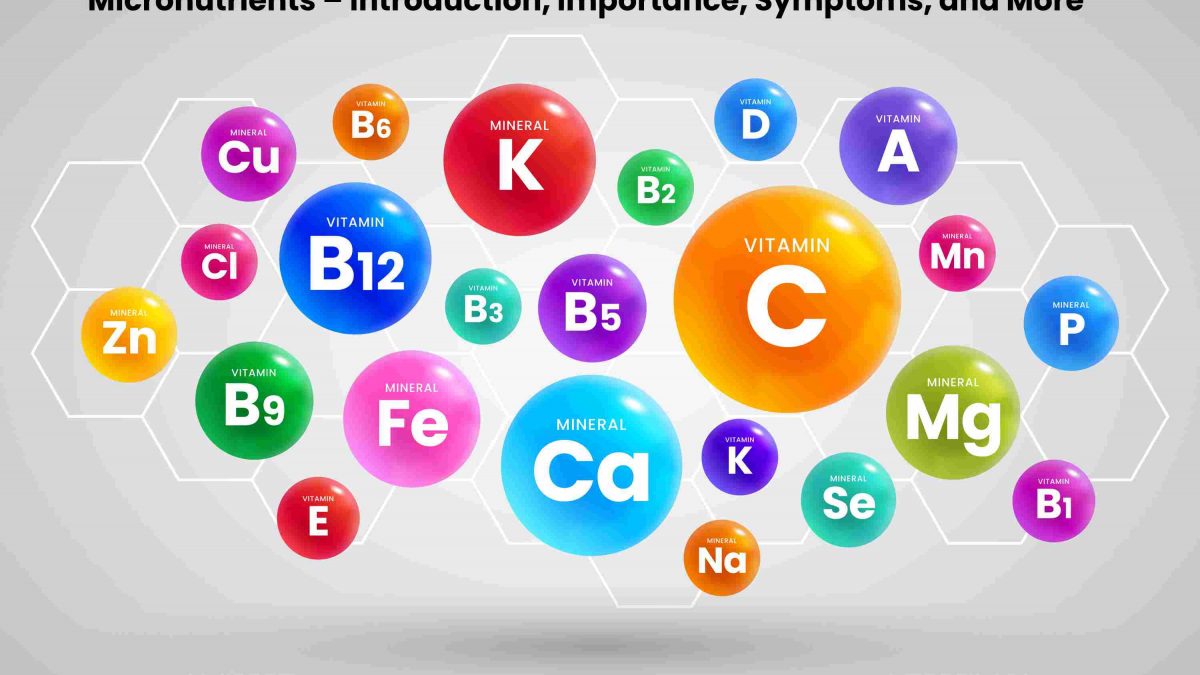Table of Contents
Introduction
Micronutrients, usually derived from food intake, are small amounts of vitamins and minerals that the body needs for most cellular functions. Firstly, Micronutrient deficiencies include vitamin A, vitamin D, vitamin B12, iron, iodine, and zinc. Secondly, Micronutrient deficiencies can lead to poor eye health, low birth weight, a negative impact on physical and cognitive development in children, and an increase in the risk of chronic diseases in adults. Therefore, Strategies focused on eating various nutrient-dense foods, fortified foods, and vitamin supplements can help prevent micronutrient deficiencies.
However, vitamins and minerals can divide into four categories: water-soluble vitamins, fat-soluble vitamins, macrominerals, and trace elements.
Regardless of the type, vitamins and minerals absorb into the body. It interacts with many processes.
Water-Soluble Vitamins
Therefore, most vitamins are soluble in water. When consumed in excess, they are aloof in the urine. While each water-soluble vitamin has a unique part, its functions are consistent. For example, maximum B vitamins act as coenzymes that help activate critical chemical responses. Most of these reactions are essential for energy production.
Water-Soluble Vitamins and their Functions:
B1 (thiamine): helps convert nutrients into energy.
B2 (Riboflavin): It is essential for energy production, cell function, and fat metabolism.
B3 (niacin): favours the production of energy from food.
B5 (pantothenic acid): it is necessary to synthesise fatty acids.
B6 (pyridoxine): Helps the body release sugar from stored carbohydrates for energy and form red blood cells.
B7 (biotin): is involved in the metabolism of fatty acids, amino acids, and glucose.
B9 (folate) – is essential for proper cell division.
B12 (cobalamin): is necessary for the formation of red blood cells and the proper functioning of the nervous system and the brain.
C (ascorbic acid): essential for creating neurotransmitters and collagen, the main protein of the skin.
As you can see, water-soluble vitamins are essential for energy production, but they also have many other functions.
In What Foods can these Micronutrients be Found?
B1 (thiamine): whole grains, meat, fish.
B2 (riboflavin): organ meats, eggs, milk.
B3 (niacin): meat, salmon, green leafy vegetables, beans.
B5 (pantothenic acid): organ meats, mushrooms, tuna, avocado.
B6 (pyridoxine): fish, milk, carrot, potato.
B7 (biotin): egg, almonds, spinach, sweet potato.
B9 (folate): beef, liver, cowpeas, spinach, asparagus.
B12 (cobalamin): oysters, fish, meat.
C (ascorbic acid): citrus fruits, bell peppers, Brussels sprouts.
fat-soluble vitamins
Fat-soluble vitamins are insoluble in water. They are well absorbed when consumed along with a cause of fat.
After consumption, fat-soluble vitamins store in the liver and fatty tissues.
The Names and Purposes of the Fat-Soluble Vitamins are:
V A: helps improve vision and organ function.
Vitamin D – Boosts immune function and aids in calcium absorption and bone growth.
V E: promotes immune function and acts as an antioxidant, protecting cells from damage.
Vitamin K: Necessary for blood coagulation and proper bone development.
In what foods can these vitamins be found?
Vitamin A: Retinol (liver, dairy, fish), carotenoids (sweet potato, carrot, spinach)
V D: Sunlight, fish oil, milk.
Vitamin E: sunflower seeds, wheat germ, almonds.
V K: Green leafy vegetables, soybeans, pumpkin.
Macro Minerals
Macro minerals are considered “electrolytes” and are needed more than trace elements to fulfil their function.
These are the Macro minerals and their Functions:
However, Calcium is necessary for the correct structure and function of bones and teeth. Thus, It helps muscle function and contraction of blood vessels.
Phosphorus: it is a portion of the structure of the bone and the cell membrane.
Magnesium: Helps in more than 300 enzymatic reactions, including blood pressure regulation.
Sodium – Provides electrolytes, which help balance fluids and maintain blood pressure.
Chloride: Usually found with sodium. It is used to make digestive juices. It helps continue fluid balance as well as sodium.
Potassium: electrolyte maintains the liquid state in cells and helps nerve conduction and muscle function.
Sulfur: is part of all living tissues. It Contains methionine and cysteine in amino acids.
Recommended sources of macro minerals
Calcium: Dairy products, green leafy vegetables, broccoli.
Phosphorus: salmon, yoghurt, turkey.
Magnesium: Almonds, cashews, black beans.
Sodium: salt, processed foods.
Chloride: algae, salt, celery.
Potassium: lentils, pumpkin, banana.
Sulfur: Garlic, onion, Brussels sprouts, eggs, mineral aquatic.
trace elements
Trace elements are needed in less quantity than macro minerals. However, they provide essential functions in the body.
Some Trace Elements and their Functions:
Iron: Helps provide oxygen to muscles and form certain hormones.
Manganese: helps the metabolism of carbohydrates, amino acids, and cholesterol.
Copper: Necessary for the formation of connective tissue and the normal function of the brain and nervous system.
Zinc: necessary for average growth, the immune system, and wound curing.
Iodine benefits the regulation of the thyroid.
Fluoride: essential for the development of bones and teeth.
Selenium: Important for thyroid health, reproduction, and defence against oxidative damage.
Recommended sources of trace elements
Iron: navy beans, spinach.
Magnesium: pineapple, walnuts, peanuts.
Copper: liver, crabs, cashews.
Zinc: Oysters, crab, chickpea.
Iodine: Algae, cod, yoghurt.
Fluorine: Juice, water, crab.
Selenium: Brazil nuts, sardines, ham.
Health Benefits of Micronutrients

All micronutrients are essential for the body to function correctly. Consuming adequate amounts of vitamins and minerals is the key to optimal health. It can even help fight disease. This is because micronutrients are part of almost every process in the body. Also, nearly vitamins and minerals can act as antioxidants.
Antioxidants may protect against cell damage associated with specific diseases such as cancer, Alzheimer’s, and heart disease. For example, studies have linked an adequate dietary intake of vitamins A and C with a lower risk of certain types of cancer. These studies show that consuming sufficient amounts of all micronutrients, especially those with antioxidant properties, provides health benefits.
How Vital are Micronutrients for Fitness?
Macronutrients are foods that directly provide the energy we need to live, work, compete, and be active. However, micronutrients contribute to this process, even if they are not direct energy sources. Athletes and coaches focus more on macronutrients when planning a better diet.
Vitamins, for example, are essentially coenzymes. They work with enzymes and provide chemical reactions in the body. An example of how this affects energy and fitness is vitamin B3 and niacin. Vitamin B3 coenzyme is necessary for forming the molecule NAD, an electron carrier essential to the energy transfer process.
Minerals such as calcium, phosphorus, and magnesium are found in the skeleton and structure of the teeth. The human body needs different amounts of each mineral to stay healthy. Minerals like iron and cobalt are essential in blood production, while zinc is essential for the immune system. Mineral deficiencies can lead to various health problems, such as bone loss, fatigue, or immune system disorders.
What are the Symptoms of Mineral Deficiency?
Among the most common that may indicate that there may be a problem are:
- Fatigue
- Weak point
- Dry Skin
- Impaired immunity
- bleeding gums
- Anaemia
- Eyesight problems
- bruise easily
- Memory loss
- Muscle cramps
Importance of Macronutrients and Micronutrients
A healthy diet is a fundamental basis for keeping our body nourished and thus avoiding the risk of non-communicable diseases. The increase in the production of processed foods and a sedentary lifestyle have transformed eating habits, generating repercussions on health.
Thinking about health and a more conscious diet, at Nestlé Contigo, we want to explain what macronutrients and micronutrients are so that you can build a balanced diet. According to the World Health Organization, people today consume many hypercaloric foods, fats, free sugars, and salt. Therefore, the consumption of fruits, vegetables, and cereals has decreased.
Nutrient Composition
Nutrients are substances found in food composition with specific properties and functions in our body. These nutrients come into action once we eat food and digest it. Nutrients are classified according to their role in our body: macronutrients and micronutrients. Thus, the first are carbohydrates, proteins, and fats; the latter are vitamins and minerals.
What are Macronutrients
The primary function of macronutrients is the supply of energy obtained through the use that cells make of macronutrients. We are sure you know that the unit of measure for energy content in calories. Although the primary function of macronutrients is to provide us with energy, each food in this group fulfills an essential role in the maintenance of life:
Proteins: structural, hormonal, and enzymatic functions, such as signaling.
Carbohydrates: energy function.
Fats: hormonal functions, transport, cell structure.
Therefore, everybody needs calories to maintain temperature, move, exercise, and perform other vital functions at rest. In short, our body loves macronutrients because it needs them.
Now, Where are the Macronutrients? Well, they are Present in Different Foods:
- carbohydrates
- fats
- protein
Carbohydrates are found in milk, honey, fruits, bread, pasta, rice, and other cereals. Proteins are mainly present in meats, such as meats, poultry, fish, shellfish, eggs, legumes, and nuts. Finally, fats are found in avocados, olive oil, nuts, oily fish, dairy products, and eggs.
How is Mineral Deficiency Treated?
Treatment of a mineral deficiency depends on the type and severity of the deficiency. In the case of vegans and vegetarians, for example, they may lack iron, B vitamins, and zinc. At the same time, those following a gluten-free diet should pay close attention to their B vitamins, such as folic acid and thiamin.
Other underlying conditions that lead to deficiency are also a factor. For example, those who have recently had surgery suffer from ulcerative colitis or celiac disease. Before proceeding with the treatment of mineral deficiency, the doctor may order some tests.
It may include treatment of other conditions or changes in medications used.
Diet Changes
However, If you are deficient in a small number of minerals, a change in dietary habits may help correct the deficiency. Thus, people with iron deficiency anaemia may ask to eat more red meat, poultry, eggs, and iron-fortified cereals. Those with severe mineral deficiency should visit a specialist. Therefore, the nutritionist can develop a nutritional program for a balanced diet rich in fruits, vegetables, and whole grains.
You may also ask to keep a food diary to keep track of the foods you have eaten and your progress.
Supplements
However, some mineral deficiencies treat with diet alone. These are taken alone or with other supplements that help the body absorb or use minerals. For example, vitamin D takes with calcium. Your doctor or well-being care professional will decide how often you should take the supplements. It is essential to follow health care instructions at this time, as excessive intake of some supplements can be harmful.
Conclusion
Micronutrients are elements that do not provide energy but are essential for the proper functioning of our bodies.
In this group, we find:
- vitamins:
- Water-soluble: there are eight B vitamins and vitamin C.
- Fat-soluble: vitamins A, D, K, or E.
- Minerals and Trace Elements: This group includes calcium, phosphorus, magnesium, sodium, potassium, chlorine, sulfur, iron, iodine, zinc, copper, chromium, selenium, and fluorine. Therefore, a stable diet provides our body with the vitamins and minerals necessary to function correctly.

